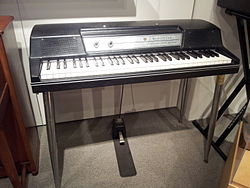Wurlitzer electric piano
 |
|
| Other names | Wurly |
|---|---|
| Classification | Electric piano, keyboard |
| Inventor(s) | Benjamin Miessner |
| Developed | 1935, 1954 and 1984 |
| Builders | |
| Wurlitzer | |
The Wurlitzer electric piano, trademarked the "Electronic Piano" and referred to by musicians as the "Wurly", was one of a series of electromechanical stringless pianos manufactured and marketed by the Rudolph Wurlitzer Company of Corinth, Mississippi, U.S. and North Tonawanda, New York. The earliest models were made in 1954 and the last model was made in 1984. Since then the Wurlitzer electric piano sound has been recreated on digital keyboards, and the vintage models are sought by musicians and collectors.
The Wurlitzer piano is usually a 64-note instrument whose keyboard range is from A an octave above the lowest note of a standard 88-note piano to the C an octave below the top note of an 88-note piano. Tone production in all models comprises a single steel reed for each key, activated by a miniature version of a conventional grand piano action and forming part of an electrostatic pickup system using a DC voltage of 170v. A mechanical sustain pedal similar to that of a conventional piano is fitted.
Inventor Benjamin Miessner had designed an amplified conventional upright piano in the 1935, and Wurlitzer used his electrostatic pickup design, but replaced the strings with struck steel reeds. The instrument entered production in 1954 as the EP-110, followed by the 111 and 112 of 1955, and continued to be produced in various forms until about 1982 when production of the EP-200A ceased.
Most Wurlitzer electric pianos are portable models with removable legs and the sustain pedal attached via a Bowden cable; console, "grand" and "spinet" models were also produced with a permanently attached pedal. The early models sustain pedals actually attached through the side of the instrument, with the pedal eventually being connected directly under the unit in the late 1950s.
The earliest versions were the "100" series; these had a case made from painted plywood and were fitted with a single loudspeaker mounted in the rear of the case. Apart from the 1950s models (110, 111, 112, 112A, 120), the portable Wurlitzer pianos featured a tremolo effect with fixed rate but adjustable depth. Models produced until the early 1960s used vacuum tube circuitry; the 140 was the first solid-state model, introduced in 1962. The model 145 was tube and came out around the same time as the 140 solid state pianos. Ultimately, after revisions designated with "A" and "B" suffixes, both were replaced in 1968 by the plastic-bodied 200, a much lighter instrument (56 lbs, without the legs or pedal) with two loudspeakers facing the player. This model was updated as the 200A in 1974 and continued in production into 1983. The 200 was available in black, dark "Forest Green", red or beige. The 200A was only available in black and avocado green. The white Wurlitzer sometimes seen being used by bands such as The Beach Boys, The Carpenters and Supertramp was a custom painted finish not made by the manufacturer. The last version to be introduced was the 200B in 1978; this was visually identical to the 200A but was designed to be powered by a pair of medium-tension (85v) rechargeable batteries; it had no internal speakers or amplifier.
...
Wikipedia
